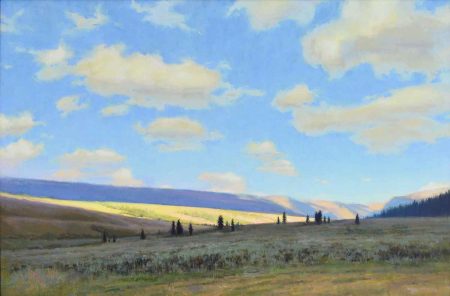Leave your comfort zone and imagine trekking into the wilds of Wyoming with artists Chuck Marshall and Robert Hagberg. Descriptive plein air paintings, several of them executed in the wilds, are contemporary interpretations of Wyoming wilderness currently exhibited at Eisele Gallery.
The concept that inspired the “Into the Wilderness” experience of Hagberg and Marshall, was started by a well-known artist Tucker Smith from Pinedale, Wyoming. Smith organized a tour for plein air artists in the Wind River Range, which is about 80 miles long in Wyoming as inspiration for their painting. An outfitter guide brings the materials and staples for the planned timeframe. The artists arrive on horseback with pack mules at the camp, a 3-4 hour ride from civilization. Enthusiasm for camping and successful fly fishing skills also come in handy. Following in the footsteps of American wildlife artist Carl Rungius (1869-1959) whose paintings depict the Wind River Range in his era, Marshall and Hagberg set out to reinterpret the wilderness in contemporary terms.
Interestingly, this exhibit captures more than the natural untouched landscape, often aligning what the eye sees with what the human feels as a lone camper on the trail. The show displays a variety of sizes. Smaller works are oil on panel which probably were executed on the trail. Larger expansive paintings are products of concentrated studio finish.
Chuck Marshall’s large oil entitled “Green River Basin” sets the stage. The broad open meadowland is inviting under drifting nebulous cloud forms. Brush and wildflowers undulate gently on a middle ground of cool greens and hints of heather. Distant craggy bluffs, dappled in warm sunlight, lure you onward with the promise of more natural beauty.
Robert Hagberg paints a closer view of the transition from meadowland to mountain passes in his “Searching for Lost Eagle Peak”. He writes “What amazed me was the dramatic difference in the contours of the peak as our perspective change from this valley to that from Slide Lake.”
With daily outings on the trails, the artists explored the deepening wilds, ascending the ranges to create studies of the country’s natural beauty. This writer liked Chuck’s view from the back of his horse. One can almost feel the gentle rhythm of the unhurried ride through the cool shadows of the foreground as he follows the guide and pack mule into the valley of a sunlit mountain range.
Marshall paints “Into the Woods”, a larger oil painting which captures glinting sunlight on the waterway meandering through the foreground meadows. The setting is crowned by looming purple snow-tipped ridges, observed by a lone pine in the foreground. Many of Marshall’s compositions offer a poetic aesthetic combined with a stronger harmonic color palette. “Square Top Mountain” appears in numerous studies by both artists and is named for its iconic blunted plateau which towers over placid lakes and streams. Other paintings depict crashing cold water streams and placid lakes, among them “Rungius Pond”, “Shirley Lake” and “Slide Lake”. Each composition relates the reflecting lakes to specific descriptions of mountain range that pinpoint the artist’s vantage point.
Close observation of several of Hagberg’s paintings reveals his brisk brush marking technique that accounts for the textural surface of his representations. Contrasting his surface work is a brilliant orange and vermillion underpainting breaking through, especially in the foreground, invigorating the darker greens and complimenting the blues. Overall his works lean toward a colorful shape and texture rendering of observed scenes.
By contrast, Marshall doesn’t seem to have a preferred ground tone and may be working straight onto a primed surface. Marshall’s brush work employs a softer handling overall with a stronger color palette and a greater sensitivity to atmospheric conditions. Marshall also exhibits a few smaller works capturing camp life, and rest on the trail. “Cowboy and His Mule” is a portrait of this indispensable animal being tended by the outfitter in camp. Also of particular interest in this exhibition is the journalistic tag copy that accompanies many pieces. These are simply written recollections by the artists, divulging treasured personal memories, fractious weather incidents, adding the campfire storytelling aspect to the empirical experience.
“Into the Wilderness” Exhibition is accompanied by a generous selection of related works from the gallery collection, blending contemporary works and historic collectables. Exhibition is on view through November 30th, 2019.
–Marlene Steele






